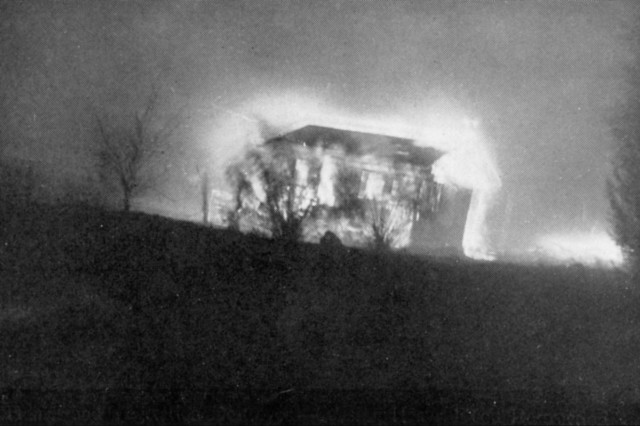An Object of Contempt and Curiosity to a Testament of Hope
At quick glance, the picture looked unremarkable and vaguely familiar like something I might have on my iPhone. After introspection, it reveals stories about community, immigration, tradition, and a historic earthquake.

Published May 1, 2024
While refiling a stack of Los Angeles Times newspaper magazines recently used by a researcher from Connecticut, the March 1907 issue caught my eye—a portrait of a Chinese father and child.
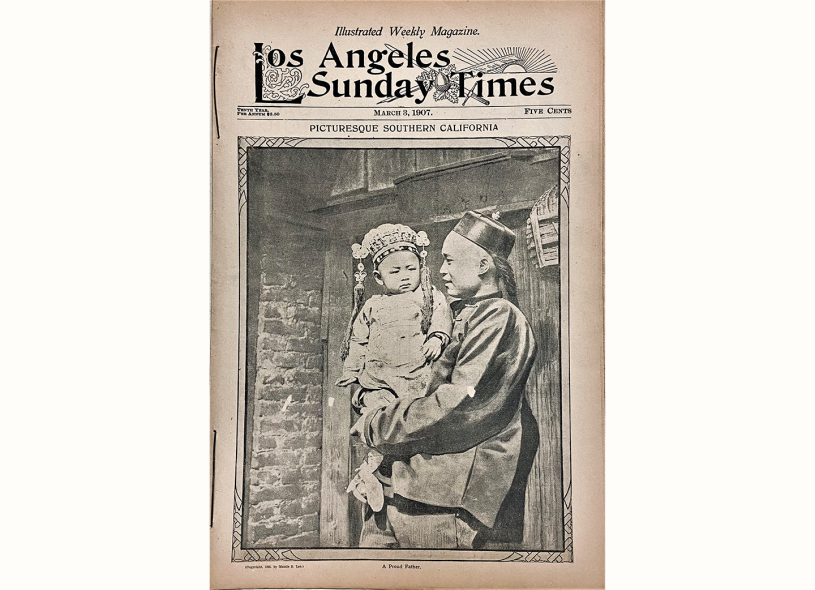
The picture struck a chord with me both on a professional and a personal level. Out-of-door photographs in this time period were not usually up close and intimate. They were void of family units, but rather mostly distant shots of men working or people in motion. Old Chinatown (the original 19th-century Chinese community replaced by the 1939 Los Angeles Union Passenger Terminal, commonly called Union Station) is documented for example in the Seaver Center’s Frank Layton Washburn collection and depicts shadowy street figures taken in a voyeuristic fashion. Stealthy pictures often showed the back sides of individuals and an occasional hand shielding the face from the camera. Any front-facing scenes took place at parade celebrations.
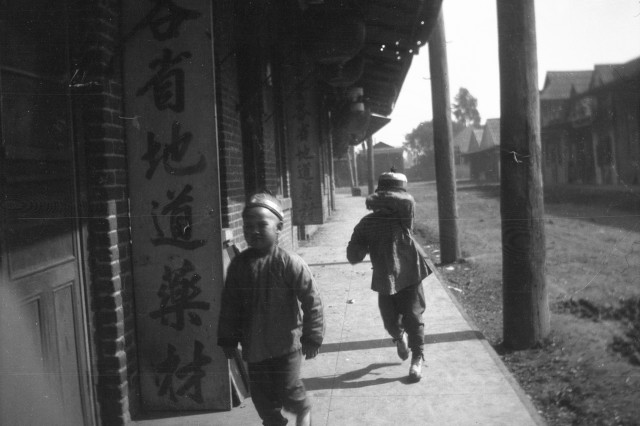
Courtesy of the Seaver Center for Western History Research
These photos from the Frank Layton Washburn collection display rarely-seen images of Old Chinatown
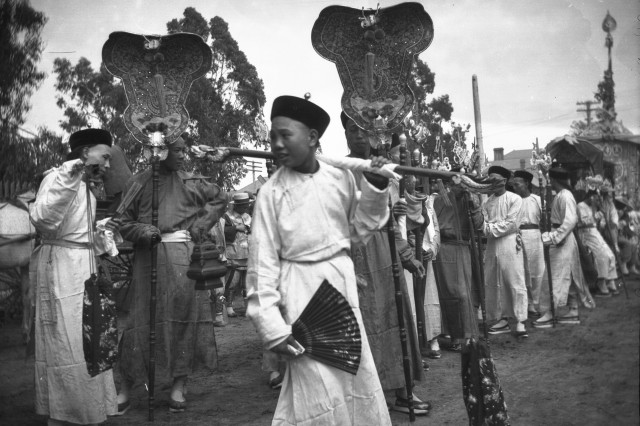
Courtesy of the Seaver Center for Western History Research
Celebrants prepare for the parade
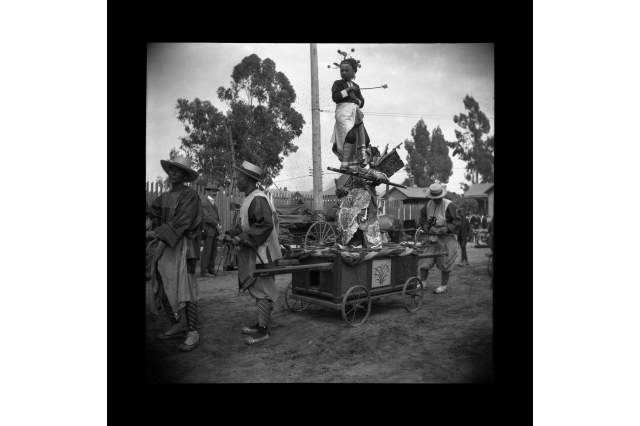
Courtesy of the Seaver Center for Western History Research
Celebrants ready a float
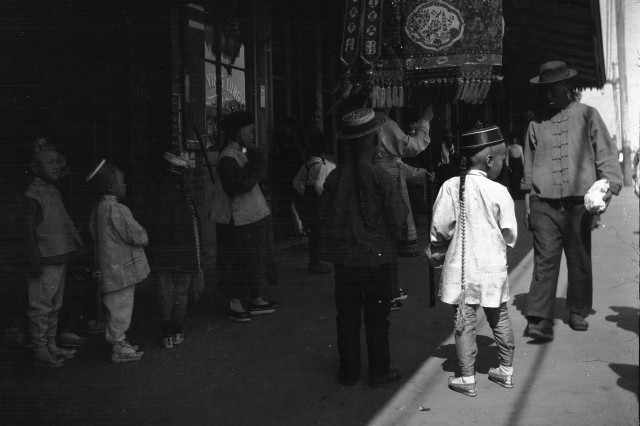
Courtesy of the Seaver Center for Western History Research
Revelers of all ages prepare for the festivities
1 of 1
These photos from the Frank Layton Washburn collection display rarely-seen images of Old Chinatown
Courtesy of the Seaver Center for Western History Research
Celebrants prepare for the parade
Courtesy of the Seaver Center for Western History Research
Celebrants ready a float
Courtesy of the Seaver Center for Western History Research
Revelers of all ages prepare for the festivities
Courtesy of the Seaver Center for Western History Research
Questions arose in my mind—who was this man in the photo? Did the unnamed man know my Chinese great-grandfather, Wah Lee Lieu, who lived in Los Angeles and worked as a cook? Was he a merchant, a minister, or else in a higher social position that afforded him a family? The child, looking to be a boy, wore a traditional headdress probably to celebrate a special holiday. Unlike the man in the picture, my ancestor sent money to his wife and extended family in Toishan, southern China—a regular practice in the era’s bachelor and sojourner society. Both men shared in common having to endure a climate of hostility amidst the decades-old Chinese Exclusion Act of 1882.
This magazine cover is full of anomalies. While newspapers like the Los Angeles Times have long been reproduced on microfilm and later digitally, inserts such as the Sunday magazines were never preserved. The Seaver Center holds a small, rare, and incomplete run.
The intimate composition shows a beaming parent, and both the camera and the man are focused on the toddler – an unusual street portrait. The photographer likely came away with this picture by befriending the man at ease during the happy atmosphere of the Chinese New Year. The photo was credited to Maude S. Lee. She was listed in the 1900 census, and by my calculation, she was about 23 years old when the photo was taken in 1905. She was not Chinese. The Los Angeles Times newspaper picked submissions from readers for publication.
Another peculiarity with the magazine cover is its humanistic portrayal of the Chinese man in contrast to the newspaper’s anti-Chinese stance. In the premiere first week of the newspaper a headline read “The Heathen Chinee” on December 4, 1881. In ensuing years the paper expressed disdain and irony, such as these paraphrased examples: Chinatown should be declared a nuisance – stop patronizing Chinese labor and business (1882); and despite the terrible condition of Chinatown streets there is no decrease in the visitation of tourists (1905).

By January 1907, the paper wrote that unless the Geary Act (a law extending the Chinese Exclusion Act) was loosened up, Chinese throughout the coast would disappear while southern California fruit growers need “to get laborers to save their perishing crops.” The timely magazine cover in the March issue may have served as a measure to soften the image of the “celestial.”
New Year’s festivities took place in February, and the Times reported that this year would be different: the community had increased due to new settlers uprooted from San Francisco’s Chinatown after the April 1906, earthquake and fire, and that “the Chinese have largely closed their doors and have their festival behind closed curtains.” Detailed were Chinatown tour guides who led sightseers traipsing through private homes. The Los Angeles Herald newspaper also wrote about rowdy hoodlums entering Chinese neighborhoods.
Lastly, the photographer offered a clear vantage point to see the man’s hairstyle. Typically with a half-shaved head and braided mane, the queue was worn to express loyalty to the Manchu tradition during the Qing Dynasty. Still in power in 1907, the dynasty fell four years later.
The little boy likely had many playmates in spite of laws stymying Chinese settlers. Another Angeleno about the same age as this boy was future actress Anna May Wong. It is hoped that the young fella grew up to experience many, many more joyful lunar new years.
